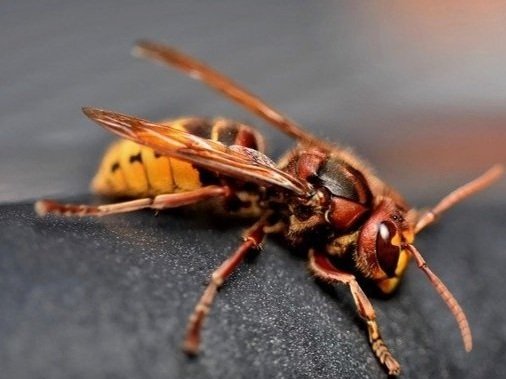The Asian Hornet - what’s the problem?
In short, the Asian Hornet (Vespa velutina, the yellow legged hornet) preys on a wide range of insects including honeybees and disrupts the ecological role they provide. It has also altered the biodiversity in regions of France where it is present and can be a health risk to those who have allergies to hornet or wasp stings.
Thought to have been imported in a consignment of pottery from China, its appearance in Europe was confirmed for the first time in Lot-et-Garonne in the South West of France in 2004. By December 2022, Asian hornet was established in Spain, Belgium, Netherlands, Portugal, Italy, Switzerland, Germany and Jersey. In 2016, the Asian hornet was discovered in the UK for the first time, in Tetbury.
Having no natural predators, and one queen able to to produce approx. 6000 individuals in a season, of which an average of 350 are potential queens and male hornets for mating, it is easy to see how this invasive species can spread so rapidly.
From July onwards, Asian hornet predation on honeybee colonies begins and increases until the end of November. Hornets can be seen hovering outside a hive entrance, waiting for returning foragers. When they catch a returning bee, they will take it away and feed off the protein rich thorax. The hornet brood requires animal proteins which are transformed into flesh pellets and then offered to the larvae.
The situation in Kent
On 29th September (2023) the latest figures for the number of nests found in England are 60 nests in 47 locations, the majority of those have been in Kent and Sussex with the Dover & Folkestone areas being hot spots and Maidstone having at least three nests found and destroyed. At the present time the National Bee Unit (NBU) are investigating several credible sightings of Asian Hornets in Kent but they haven’t specified where yet, figures will be updated again later this week and are available for all to see on the NBU website https://www.nationalbeeunit.com/about-us/beekeeping-news/2023-asian-hornet-rolling-updates/
If nests are not found before the new queens for 2024 fly from the nest and hibernate I would fully expect to see Queen Asian Hornets in Marden next year so I will be setting selective Queen traps in my apiary and garden to try to catch any before they set up a new nest. (Selective traps have smaller holes near the top that allow other insects to escape.) Considering new queens can fly up to 70 miles before setting up a new nest site they will be found all over the South East if nests are missed, so the rush is on to find and destroy all nests before next year’s queens are produced.
Because of the devastating effect Asian Hornets can have on honey bee populations as well as a range of other native pollinators and beneficial insects the Government wants to monitor the spread of the Asian hornet. This is where we can help by reporting any sighting of an Asian hornet in our gardens or elsewhere.
How to recognise an Asian Hornet
The important thing is not to confuse it with a native European Hornet , which is larger.
ASIAN HORNET (Vespa velutina)
Queen up to 30mm long, worker up to 25mm long
Legs yellow at the ends
Dark brown / black abdomen with a yellow / orange band on 4th segment
Head dark from above, orange from front
Dark coloured antennae
Entirely black velvety thorax
Never active at night
EUROPEAN HORNET (Vespa crabro)
Queen up to 35mm long, worker up to 30mm long
Legs brown at the ends
Yellow abdomen marked with brown on the upper part, not banded
Head yellow from above, yellow from front
Yellow antennae
Thorax black with extensive brown markings
May be active at night
How to report a sighting
Notify the Great British Non Native Species Secretariat (NNSS) immediately. In the first instance sightings should be reported through the free Asian Hornet Watch App, available for Android and iPhone. Other methods include using the NNSS online notification form. Finally, you can send any suspect sightings to the Non Native Species email address alertnonnative@ceh.ac.uk. Where possible, a photo, the location of the sighting and a description of the insect seen should be included.

